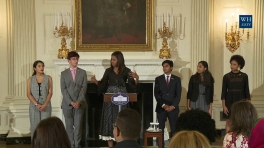Investing in Pell Grants to Make College Affordable
“We will provide the support necessary for you to complete college and meet a new goal: by 2020, America will once again have the highest proportion of college graduates in the world.” - President Barack Obama February 24, 2009
Pell Grants are the foundation of our national efforts to make college affordable. Unfortunately, their purchasing power has diminished over time. Since coming into office, President Obama has worked aggressively to increase the maximum Pell award because he recognizes that for millions of Americans, Pell Grants are the primary form of financial aid they use to pay tuition. The Health Care and Education Reconciliation Act strengthens the Pell Grant program for students and families by:
- Raising the Maximum Pell Grant and Assuring that It Continues to Grow: Pell Grant scholarships help more than 8 million Americans a year afford college, but the purchasing power of these grants has rapidly diminished over time. The Health Care and Education Reconciliation Act invests more than $40 billion in Pell Grants to ensure that all eligible students receive an award and that these awards are increased in future years to help keep pace with both inflation and the rising costs of college. These investments, coupled with the funding provided in the Recovery Act and the President’s first two budgets, will more than double the total amount of funding available for Pell Grants since the President took office. The bill will increase the Federal Pell Grant maximum award by the Consumer Price Index from 2013 through 2017, which is estimated to raise the maximum grant for students from $5,550 to $5,975 according to non-partisan Congressional Budget Office estimates. By the 2020-2021 academic school year, more than 820,000 additional Pell Grant awards are expected to result from this new law.
- Stabilizing Pell Grant Funding: The budgeting process for Pell Grants often leads to funding shortfalls. The current shortfall is particularly severe because of the large number of students and workers qualifying for the award that have recently returned to school. The Health Care and Education Reconciliation Act covers the expected funding shortfall and much of the recent growth in Pell costs, putting the program on more secure footing for years to come.
- Investing in Students Rather Than Subsidizing Banks: The Health Care and Education Reconciliation Act pays for increased investments in Pell Grants by reforming the current student loan programs. Delivering all student loans through the direct student loan program—instead of subsidizing banks through the more costly Federal Family Educational Loan program— will save taxpayers nearly $68 billion by 2020 according to the Congressional Budget Office. The bill reinvests these savings in students.
These commitments complement President Obama’s broader agenda for higher education that includes:
- Expanding income based repayment options for borrowers with unmanageable debt.
- Increased investments in America’s community colleges, Historically Black Colleges and Universities, Hispanic-Serving Institutions, Tribal Colleges and Universities and other Minority Serving Institutions.
- Simplifying the federal student aid application (FAFSA) to make it easier to apply for financial aid for college.
- Tripling the largest college tax credit, now known as the American Opportunity Tax Credit.


